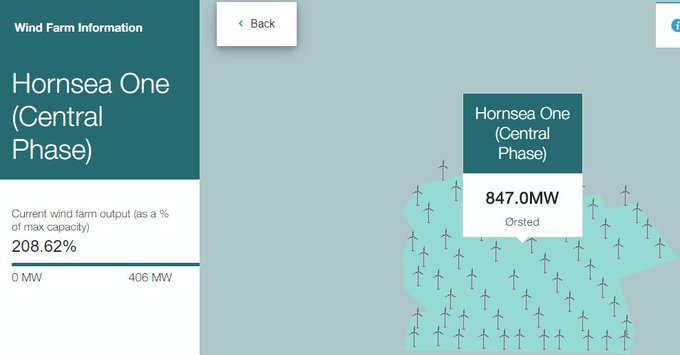Lessons from the UK's August 9 blackouts
An interim report is out from National Grid on the "Low Frequency Demand Disconnection" (LFDD) experienced in the UK on August 8th. There were a number of contributors to the LFDD. Instead of looking for a single culprit it would be better to list the contributors, because it's the interaction that resulted in the event. I'll review the failures in the UK to highlight a recent report from Ontario's system operator (IESO) that has received too little attention.
Many suspected wind as the primary factor on August 9th, and the Hornsea offshore wind facility was heavily involved. So far that involvement has simply been identified as its failure to ride through a voltage dip caused by a lightening strike to transmission wires elsewhere.
From a useful infographic accompanying the report:
- "There was a lightning strike on a transmission circuit north of London ..."
- "There was a small loss of embedded generation (c.500MW) due to the lightning strike. This is normal ..."
- Little Barford gas power station and Hornsea wind reduced supply to the grid by 1,378 MW
The last bullet point grabs the most attention, the first triggered the event despite being a common occurrence which was typically handled; but it is the middle point that should instigate changes in the operations of the grid.
I suspected wind, as did many others, because earlier in the day a "NEW WIND RECORD!" was announced by RenewableUK: " at 5am this morning metered transmission wind was generating 47.6% of GB electricity. Additional wind connecting directly to local networks make it highly likely wind was powering over 50% for the first time!" This may yet prove critical, but, unlike in South Australia back in 2016, there was a single wind facility most responsible.
Hornsea wind failed in a circumstance it should have handled easily. One area I'd want the final report to cover is the approach to commissioning new resources. In June the first phase of Hornsea was happily announced to have "over 50 of the 174 Siemens Gamesa turbines currently in operation." I captured the following image from The Crown Estate's offshore wind map on August 10th, noting the facility was producing over twice the shown nameplate capacity. Today the capacity shows as the full 1200 MW the site was planned to be at completion. The role of the commissioning process of the grid operator is worth investigating because the one site that failed was the one rapidly adding capacity over the past couple of months.

Little Barford failed a little more responsibly: first the steam generator, then a gas turbine and then the second gas unit. Generators do trip, and the National Grid interim's report notes contingencies exist for when they do: their standards require "an infeed [1,000 MW loss] to be covered". From that report:

The combination of an "Estimated, Embedded generation infeed loss due to Loss of Mains Protection", and the 1,000 MW planning requirement, reminded me of Ontario's system described in the Review of the IESO-Controlled Grid's Operability to 2025, published this past June. I'll allow the report to describe how a reserve capacity requirement is established and why the IESO reports it needs to increase very significantly:
The Most Severe Single Contingency (MSSC) ... refers to generation capacity lost due to a single forced outage of generation or transmission equipment. It is one of the quantities used to determine the amount of operating reserve...
Traditionally, the [IESO Controlled Grid's] MSSC was mainly determined by the largest generation unit (one unit at Darlington NGS, approximately 900 MW) that could be lost....
Projections for 2025 show the potential for 3,160 MW of [Distributed Energy Resources - DERs] (total installed capacity), which could generate up to 2,600 MW during high output conditions, being in service in Ontario. The majority of DERs follow the IEEE 1547 standard for Interconnecting Distributed Resources with Electric Power Systems, issue 2003, which requires them to disconnect as soon as voltage or frequency is outside the normal ranges.
...
Further analysis showed that a severe transmission fault within the 500 kV system that results in the loss of a Darlington [Nuclear Generating Station -NGS] unit would also lead to an additional loss of about 2,000 MW of DERs with a coincident high output of around 1,700 MW, representing a total potential generation loss of about 2,600 MW.
What is it telling us? Under certain operating conditions, the insufficient voltage and frequency ride-through capabilities of the majority of DERs could result in a large-scale loss of output. That will require the IESO to plan for new and very large MSSCs.
It strikes me as entirely plausible to argue this was only the first load shedding event the UK grid has seen for half a decade due to luck. On August 9th there may have been enough resources to provide the 1,000 contingency for generators failing, but there was not more than 1,000 MW available because wind was dominating the grid so fewer flexible generators were operating. I'd hope a review would address 3 issues:
- commissioning of new generators to ensure facilities exactly like Hornsea have full ability to ride through frequency blips before sending double their registered capacity to the grid,
- creating data visibility of embedded generators/DERs, and altering standards to allow riding through frequency blips
- re-evaluating reserve requirements to maintain frequency.
Interesting stuff, but this post is much more in need of an editor than your average.
ReplyDeleteThank you for that - I was trying to stay off the computer this week And did rush this out.
ReplyDeleteI will edit it when I get a spare hour.
Update Aug. 21: I have now edited the original post